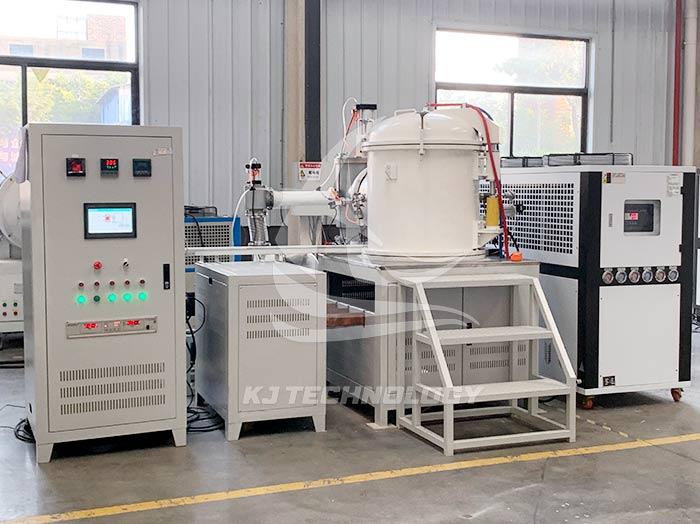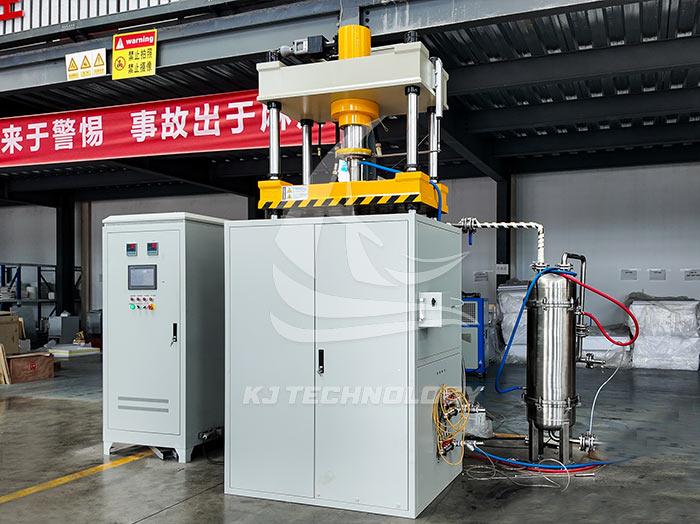What are the advantages of a vertical high vacuum hot pressing electric furnace?
 08-20-2025 Author: KJ technology
08-20-2025 Author: KJ technology
The vertical high vacuum hot pressing electric furnace combines three core functions: vacuum environment, high-temperature heating, and mechanical pressurization, demonstrating significant advantages in the field of material processing. The following are its core advantages and specific application values:
1. Ultimate material protection: avoiding pollution in a vacuum environment
Preventing oxidation and volatilization: Under ultra-high vacuum (up to 10 ⁻⁵ Pa) or inert gas protection, the material will not react with oxygen, nitrogen, etc. at high temperatures, avoiding oxidation, decarburization, or volatilization, ensuring the purity of the material composition.
Reduce impurity introduction: The vacuum environment eliminates dust, moisture, and other impurities in the air, making it particularly suitable for the preparation of high-purity ceramics, semiconductor materials, or optical components.
Application scenarios: aerospace titanium alloy components, electronic packaging ceramics, optical lenses, and other fields that require extremely high purity.
2. Precise process control: dual guarantee of temperature and pressure
High temperature control accuracy: using PID algorithm and tungsten rhenium thermocouple, temperature fluctuation ≤ ± 1 ℃, supporting multi-stage program heating, meeting complex heat treatment requirements (such as gradient sintering, rapid annealing).
Stable pressure control: The hydraulic system achieves precise pressure adjustment (± 0.1MPa), supports one-way or two-way pressurization, ensures uniform material stress, and improves density.
Synergistic effect: High temperature puts the material in a thermoplastic state, pressure promotes particle rearrangement and pore elimination, significantly reduces sintering temperature, and shortens process cycle.
3. Efficient and energy-saving: optimizing design to reduce energy consumption
Advantages of vertical structure: The vertical layout of the furnace reduces heat loss, combined with water-cooled interlayers and high-efficiency insulation materials (such as alumina fibers), resulting in a 20% -30% increase in thermal efficiency compared to traditional furnace types.
Rapid heating and cooling: Graphite carbon tube heating or induction heating achieves minute level heating, while gas circulation cooling system shortens cooling time and improves equipment turnover.
Energy saving case: After a certain enterprise used this equipment, the production time of a single batch was shortened from 8 hours to 5 hours, and energy consumption was reduced by 35%.
4. Wide applicability: Multi material compatibility
Metal materials: Hot pressing of refractory metals such as titanium alloys and nickel based alloys to solve the problems of cracking and deformation in traditional processes.
Ceramic materials: Densification and sintering of high-performance ceramics such as silicon nitride and silicon carbide to enhance material strength and wear resistance.
Composite materials: Optimizing the interface bonding of metal based composite materials (such as aluminum based silicon carbide) to achieve a balance between mechanical properties and thermal conductivity.
In the field of new energy, sintering of lithium battery electrodes and annealing of photovoltaic silicon wafers can improve battery energy density and photovoltaic conversion efficiency.
5. High degree of automation and security: reducing operational risks
Intelligent control system: PLC+human-machine interface enables one click start, automatically completing the entire process of vacuuming, heating, pressurization, cooling, etc., reducing human intervention.
Security protection mechanism:
Overpressure protection: Real time monitoring by pressure sensors, automatic pressure relief when exceeded.
Over temperature alarm: The dual circuit temperature control system prevents local overheating.
Vacuum interlock: Heating is prohibited when the vacuum degree is not reached to avoid material oxidation.
Operation case: A laboratory achieved 24-hour unmanned production through remote monitoring function, reducing the failure rate to below 0.5%.
6. Environmental compliance: Meet strict emission standards
Non polluting emissions: Closed operation in a vacuum environment, no waste gas or residue generated, in compliance with environmental regulations such as RoHS and REACH.
Low noise design: The hydraulic system adopts a silent pump, with a running noise of ≤ 65dB, improving the workshop environment.
Typical application cases
Aerospace: A certain enterprise uses a vertical high vacuum hot pressing electric furnace to prepare titanium alloy blades, achieving a density of 99.8% and a fatigue life increase of 40%.
Electronic packaging: The ceramic metalized substrate sintered by this device has an increased thermal conductivity of 25W/(m · K), meeting the heat dissipation requirements of 5G communication modules.
New energy batteries: A battery manufacturer uses hot pressing technology to produce electrode plates, reducing internal resistance by 15% and achieving a cycle life of over 2000 times.
summarize
The vertical high vacuum hot pressing electric furnace has become the preferred equipment in the high-end material processing field due to its core advantages of vacuum protection, precise control, high efficiency and energy saving, multi material adaptability, and automation safety. It can not only significantly improve material performance, but also reduce production costs, helping enterprises achieve technological upgrades and product differentiation competition.








